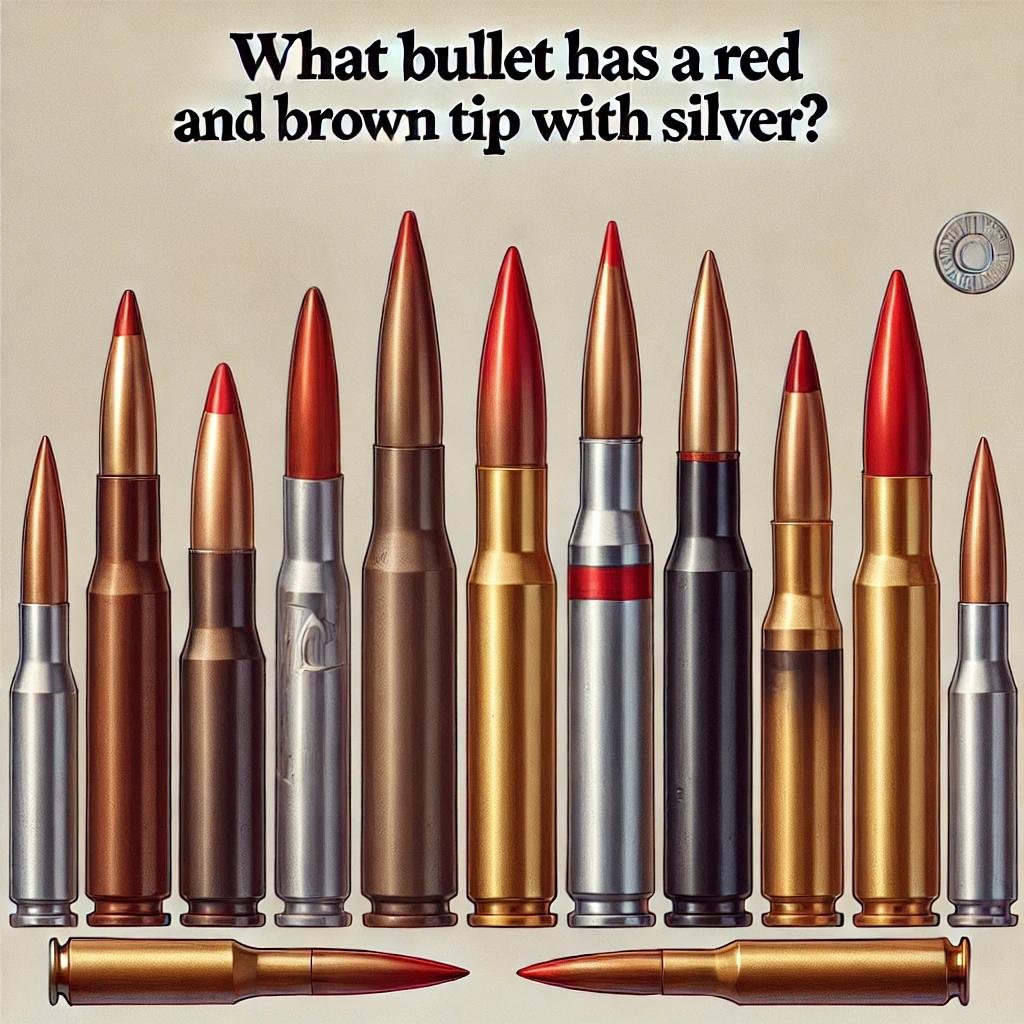Introduction: Understanding bullets can be a bit complicated, especially when it comes to features. A common question is, “What bullet has a red and brown tip with silver?” This query arises from both firearms enthusiasts and newcomers. Bullet tip colors play a key
role in identification, indicating the type, purpose, and performance of the bullet. This article will explore various bullets featuring red, brown, and silver tips.
Overview: Identifying Bullets with Red and Brown Tips
There are so many different kinds of bullets that it can be really hard just to identify them, let alone know their intended use. The ones that closely match the description of having a red and brown tip with silver are the Hornady V-Max and the Speer TNT. Both are extremely accurate for their intended purposes, but they serve different scenarios. The two bullets have differently colored tips because Hornady designed the V-Max with a red plastic tip, while Speer designed the TNT with a brown plastic tip. Both use
plastic tips to enhance accuracy in the field.
What Bullet Features a Red and Brown Tip with Silver?
When people talk about a bullet, they are typically referring to a projectile that is used in very particular applications—like hunting or shooting at a range. Bullets that fit this description and have red and brown tips with silver are often high-velocity rounds that are very accurate and have a lot of impact. One kind that might fit this description has a hollow point.
These kinds of projectiles are good at expanding. You hardly ever hear or read about them being used for anything other than “bad” purposes—like killing people. Brown tips might mean something about what the projectile is made of, or a coating, or something about the projectile that makes it “bad” in the sense of “
good for killing people.” Silver tips might mean something about the metal jacket. Or the bullet might be a combination of all those things.
Understanding the Color Coding of Bullet Tips
The visual guides in the form of color coding on the bullet tips assist not only the shooter but also the collector in quickly identifying the type of ammunition. Each color or shade represents a certain aspect or purpose, and together they help to facilitate the almost instant recognition of the rounds in question. Just looking at the color of the tip can tell you a lot about the nature of the bullet. For the .224-lot, which travels about 200-250 meters through the base you’ve just painted, would you prefer a red audiogram with a silver hunting bullet or a brown one that matches the ammunition?
Common Uses for Bullets with Red and Brown Tips
You can find bullets with red and brown tips and silver ends in many shooting scenarios The purpose they serve is varied. For one type of scenario, some of these bullets serve the hunting community. They are designed with red tips to indicate that they will expand upon impact, which ensures a clean, humane kill. But the bullets themselves don’t know where they’re being shot. For another type of shooting scenario, using these bullets in a humaniform target indicates that you are practicing for a competitive event—one where accuracy and consistency (not to mention safety) are of utmost importance. When you choose a rifle cartridge, understanding the intended purpose of the bullet is integral to ensure not only performance but also safety.
The Significance of Bullet Tip Colors: A Detailed Guide
The colors of the bullet tips are very important for identifying the use and effectiveness of the bullet. Each color usually represents a certain attribute, but what exactly they represent can vary between manufacturers. For instance, a bullet that is described as having a red tip and a brown tip with silver usually means a certain type of specialized design for certain applications. The colors of the bullet tips, when understood, can therefore enhance not only your shooting experience but also your safety. They let you know what kind of ammunition you are using and deepen the experience of using the correct and optimal type of bullet for your firearm.
How to Properly Identify Bullets with Unique Color Tips?
To identify bullets that have one-of-a-kind color tips, you need two things: good eyesight and good knowledge of the ammunition. The tip colors are the first thing to look at. A bullet that has a red and brown tip with silver (ala “What’s this bullet?” from the above) might indicate some specific performance traits, but you gotta know what you’re looking at to recognize this. The totality of the design, the weight, the calibre… all these things indicate the proper usage of what’s inside the casing. And using reference materials is mandatory if you’re serious about identifying what you seemingly should be able to identify in the first place. Remember, handle it with care.
Safety Considerations When Handling Color-Tipped Bullets
Safety is the number one priority when dealing with color-tipped bullets. Red and brown tips with silver can mean certain properties that equal “handle with care.” Always treat every cartridge as if it’s live and don’t expose them unnecessarily to heat or moisture. The color coding can also mean not using certain ammo in the certain guns that you’re using. Store everything properly, and remember, even if shooting sounds fun, it isn’t—unless you’re doing it safely and following all the rules set by those responsible for safety.
Bullet Types: Exploring Red, Brown, and Silver-Tipped Variants
A variety of bullet types inhabit the realm of ammunition, each with its own unique traits. A bullet with a red or brown tip, alongside a silver tier, likely indicates a specific type of expansion or coating, marking it as safe for particular situations. If the manufacturer is unknown, the silver tip could refer to the metal used in the bullet’s jacket, which is crucial for understanding its intended use.
Common Inquiries About Bullets with Red and Brown Tips
Bullets with distinctive colors often prompt questions from both hardcore and novice shooting fans. A typical inquiry might go something like this: “What bullet is red and brown tipped with silver?” Such a question gets right at the heart of the matter. It’s not just about looks. Many people assume that if a bullet has distinctive colors, it must function and perform differently than a bullet without those colors.
Of course, understanding color and its imaginative uses can reveal a great deal about how people use the bullets in question. But hearing a typical comment (or question) about them is often mostly just the precursor to an appearance-related discussion.
The Role of Bullet Tip Colors in Ammunition Identification
The identification of ammunition can be accomplished in an instant if you know how to interpret the colors of the bullet tips. Let’s say you find a bullet that has a red and brown tip in addition to a silver component. For the army, the bullet’s colors indicate specific performance traits and intended uses for the shooter. These colors are designed to stand out visually, considering the military’s understanding of eye physiology, at any engagement range.
Common Misconceptions About Color-Tipped Bullets
Several misunderstandings exist about color-coded bullets that could confuse people who are not familiar with the subject. For example, some people think that all colored tips indicate that the bullets serve the same function. A bullet that fits the description of one with a red and brown tip with silver may perform very different tasks from other color combinations with those same basic features. Some people believe that color coding applies only to certain kinds of ammunition. In reality, nearly all manufacturers use color coding to help you identify their bullets. Understanding what color-coded tips mean can increase your knowledge and help you handle ammunition more safely.
The Evolution of Bullet Design: Color-Coded Tips Explained
Over the years, ammunition design has taken great strides. One area of development that has supplied almost instant feedback to the shooter has been the use of color coding. Once upon a time, all projectiles were pretty much the same; they were the same basic shade of metal and looked nearly identical. Shooters had to study the writing on the box to understand what was inside. As my friend Ralph Petry once said, “These things are mostly the same until you reach the part where they’re different, and even then, they’re still mostly the same.”
Understanding the Importance of Bullet Tip Identification
Conclusion
In conclusion, understanding bullets—particularly those with a red and brown tip with silver—requires knowledge of their design, purpose, and safety. The color coding is crucial for identifying ammunition types, adding depth to the study of ballistics. The .223 round’s copper-brass look signifies speed and energy, while the .45 round’s brown and silver ceramic finish suggests a strong, shell-like purpose.







